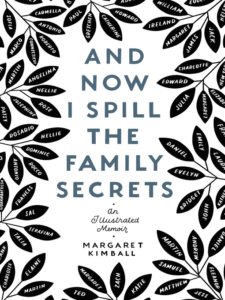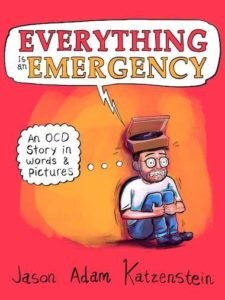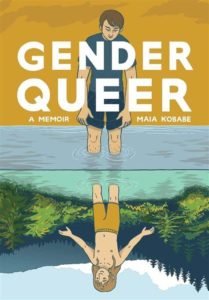In recent years, the library has added many graphic memoirs and novels as our collection continues to diversify. These illustrated books are often personal narratives that combine storytelling and imagery to convey the cartoonist’s life.
Here are some titles I recommend that are available for check out.
 Margaret Kimball’s “And Now I Spill the Family’s Secrets” a black and white minimalist art style is used to tell the story of Kimball’s family history of mental illness. The memoir starts with a narrative about how when the author and her siblings were young, their mother attempted suicide. As the story continues it becomes apparent that Kimball’s mother is not the only one in the family with psychological dysfunction. It is revealed that her grandmother was hospitalized multiple times for mental illness and the author’s brother also seems to struggle with paranoia and delusions. What is unique about this title is that the art focuses less on the characters and more on their surroundings, like the details of the author’s childhood home and the hospital rooms of family members. The story does not really touch on specific diagnoses of family members, they remain a secret, though it is not difficult to presume what mental illness they are suffering from based on their symptoms. The ambiguous drawings of Kimball’s household surroundings seem like a metaphor for appearing like a well put together family while also trying to hide the devastating reality of mental illness.
Margaret Kimball’s “And Now I Spill the Family’s Secrets” a black and white minimalist art style is used to tell the story of Kimball’s family history of mental illness. The memoir starts with a narrative about how when the author and her siblings were young, their mother attempted suicide. As the story continues it becomes apparent that Kimball’s mother is not the only one in the family with psychological dysfunction. It is revealed that her grandmother was hospitalized multiple times for mental illness and the author’s brother also seems to struggle with paranoia and delusions. What is unique about this title is that the art focuses less on the characters and more on their surroundings, like the details of the author’s childhood home and the hospital rooms of family members. The story does not really touch on specific diagnoses of family members, they remain a secret, though it is not difficult to presume what mental illness they are suffering from based on their symptoms. The ambiguous drawings of Kimball’s household surroundings seem like a metaphor for appearing like a well put together family while also trying to hide the devastating reality of mental illness.
 “Everything is an Emergency: An OCD Story in Word and Pictures” by Jason Adam Katzenstein, available on Libby, is another graphic memoir, that touches on mental illness, specifically obsessive-compulsive disorder. We meet the author during adolescence as he describes some of his first fears in life. The art style is also minimal while remaining very cartoon-like, however, instead of handwritten text typical of a graphic novel, most of the story is in type-set. As Jason becomes a teenager, he regularly sees a therapist and learns “that OCD is an inflammation of the amygdala, the part of the brain in charge of interpreting threats.” Even though Katzenstein has recognized his mental illness he still has compulsions he feels necessary to perform even into adulthood. Throughout the book there is a recurring image of the author rolling a boulder up an endless hill that represents his battle with OCD, even as the story ends the boulder is still being pushed up the hill signifying that OCD is illness and struggle that lasts for life.
“Everything is an Emergency: An OCD Story in Word and Pictures” by Jason Adam Katzenstein, available on Libby, is another graphic memoir, that touches on mental illness, specifically obsessive-compulsive disorder. We meet the author during adolescence as he describes some of his first fears in life. The art style is also minimal while remaining very cartoon-like, however, instead of handwritten text typical of a graphic novel, most of the story is in type-set. As Jason becomes a teenager, he regularly sees a therapist and learns “that OCD is an inflammation of the amygdala, the part of the brain in charge of interpreting threats.” Even though Katzenstein has recognized his mental illness he still has compulsions he feels necessary to perform even into adulthood. Throughout the book there is a recurring image of the author rolling a boulder up an endless hill that represents his battle with OCD, even as the story ends the boulder is still being pushed up the hill signifying that OCD is illness and struggle that lasts for life.
 “Gender Queer” by Maia Kobabe was awarded a 2020 Stonewall Honor Book award by the American Library Association. This graphic memoir is in full color which adds a lot of dimensions to each page. The story begins in 1992 when the author is three years old, some of eir’s first memories seemed to be about playing outside and peeing in the yard and becoming obsessed with snakes, not typical behaviors for someone assigned female at birth. As Kobabe grows up throughout the book we learn about eir’s struggle with being female as they develop gender dysphoria which appears in a fear and feelings of disgust of eir’s menstrual cycle and cutting eir’s hair short helps Maia come into eir own. It isn’t until Maia is at a party as an adult with other trans individuals that they discover eir’s preferred pronouns.
“Gender Queer” by Maia Kobabe was awarded a 2020 Stonewall Honor Book award by the American Library Association. This graphic memoir is in full color which adds a lot of dimensions to each page. The story begins in 1992 when the author is three years old, some of eir’s first memories seemed to be about playing outside and peeing in the yard and becoming obsessed with snakes, not typical behaviors for someone assigned female at birth. As Kobabe grows up throughout the book we learn about eir’s struggle with being female as they develop gender dysphoria which appears in a fear and feelings of disgust of eir’s menstrual cycle and cutting eir’s hair short helps Maia come into eir own. It isn’t until Maia is at a party as an adult with other trans individuals that they discover eir’s preferred pronouns.
These titles and other graphic memoirs/novels are available for check out at the library or through our e-library. I hope you enjoy them as much as I did!

